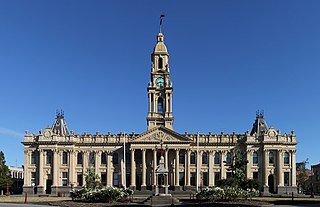
Swanston Street is a major thoroughfare in the centre of Melbourne, Australia. It is one of the main streets of the Melbourne central business district and was laid out in 1837 as part of the original Hoddle Grid. The street vertically bisects Melbourne's city centre and is famous as the world's busiest tram corridor, for its heritage buildings and as a shopping strip.

Melbourne tram route 72 is operated by Yarra Trams on the Melbourne tram network. It operates from Melbourne University to Camberwell. The 16.8 kilometre route is operated by Z and D class trams from Malvern depot.

Melbourne tram route 112 was operated by Yarra Trams on the Melbourne tram network. It operated from West Preston to St Kilda. The 18 kilometre route was operated by A, B and D2 class trams from East Preston depot.

Melbourne tram route 96 is operated by Yarra Trams on the Melbourne tram network. It operates from Brunswick East to St Kilda Beach. The 13.9 kilometre route is operated by C2 and E class trams from Southbank depot.

Elizabeth Street is one of the main streets in the central business district of Melbourne, Australia, part of the Hoddle Grid laid out in 1837. It is presumed to have been named in honour of governor Richard Bourke's wife.

Melbourne tram route 75 is operated by Yarra Trams on the Melbourne tram network. It operates from Vermont South to Central Pier, Docklands, serviced by A and B class trams from Camberwell depot. At 22.8 kilometres, it is currently the longest line in the network.

Melbourne tram route 57 is operated by Yarra Trams on the Melbourne tram network. It operates from West Maribyrnong to Flinders Street station. The 11.6 kilometre route is operated by Z3 class trams from Essendon depot.

The Melbourne cable tramway system was a cable car public transport system, which operated between 1885 and 1940 in Melbourne, Victoria, Australia.

Route 55 was a tram route on the Melbourne tram network. The 12.5-kilometre (7.8-mile) route operated between Pascoe Vale South and Domain Interchange, using Z and B-class trams from Essendon depot. The service ceased on 30 April 2017.

Melbourne tram route 3 is operated by Yarra Trams on the Melbourne tram network. It operates from Melbourne University on Swanston Street to the corner of Waverley Road and Darling Road at Malvern East. The 14.9 kilometre route is operated by Z, A and B2 class trams from Glenhuntly depot. On weekends route 3 operates as route 3a and diverts via St Kilda.

Melbourne tram route 11 is operated by Yarra Trams on the Melbourne tram network. It operates from West Preston to Victoria Harbour Docklands. The 14.9 kilometre route is operated by B2, E class trams from Preston Depot.

Haymarket roundabout is a roundabout located at the intersection of Elizabeth Street, Flemington Road and Peel Street near the northwest border of the Melbourne CBD in Australia. It is also the location of two tram stops. Royal Parade appears to begin at the roundabout. However, the block north of the roundabout, as far as Grattan Street, is formally still Elizabeth Street.

The Melbourne University tram stop is a major terminating point and stop of the Melbourne tram system. It features a single island platform and three shunts. It is located on Swanston Street, Carlton, and is the major tram stop for the University of Melbourne, its name sake. It was opened in 2005 and is one of the busiest stops on the network; six tram lines terminate at it, while two run through.

Domain Interchange was a major interchange on the Melbourne tram system. At closure, it featured two island platforms with four tracks, and has dedicated turning tracks and through tracks. It was located on St Kilda Road between Domain Road and Park Street, adjacent to Kings Domain, and was one of the busiest interchanges on the system, being used by eight tram routes. The most recent structure was opened in April 2013, replacing an earlier structure built in 1986.

Melbourne tram route 12 is operated by Yarra Trams on the Melbourne tram network. It operates from Victoria Gardens to St Kilda. The 16.2 kilometer is operated by A class trams from Southbank depot.

Clarendon Street Junction is a tram stop located at the intersection of the St Kilda and Port Melbourne light rails with Normanby Road, Whiteman and Clarendon Streets in Southbank, Victoria. It is served by Yarra Trams routes 96 and 109 on the Melbourne tram network. It is also the terminus for the Colonial Tramcar Restaurant.

St Vincent's Plaza is a major interchange of the Melbourne tram network, serviced by Yarra Trams routes 11, 12, 30 and 109. It is located in the wide centre median of Victoria Parade, wedged between the intersections of Gisborne Street and Brunswick Street.
The Melbourne tram network began in 1884 with the construction of the Fairfield Horse Tramway. However, the purpose of the line was to increase land prices in the area, and it soon closed during the depression in 1890. The first genuine attempt to construct a tramway network was the construction of the Richmond cable tram line by the Melbourne Tramway & Omnibus Company in 1885. Over the next few years, 16 more cable tram lines were constructed, as well as numerous other horse tramways. The depression of the early 1890s slowed further expansion of the cable network. The first electric tram line was the Box Hill and Doncaster tramway which opened in 1889. This was a pioneering line in what was then the countryside and thus didn't receive much patronage. It closed in 1896. The next attempt at an electric tramway was Victorian Railways' St Kilda to Brighton line, which opened in 1906. Later that year, the North Melbourne Electric Tramway and Lighting Company opened lines to Essendon and Maribyrnong. Many local councils formed their own tramway trusts and built tramways within their own constituency. The most successful of these was the Prahran and Malvern Tramway Trust.






















